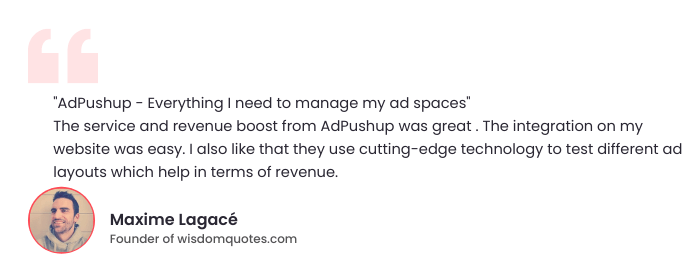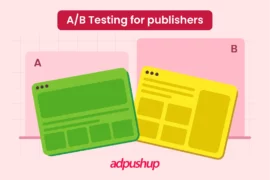Autoplay ads are good for awareness but bad for user experience. In such a case, what should a publisher do? And how should he/she go about it?
Autoplay ads are often admired by publishers and advertisers because these ads catch instant attention. However, this instant attention can be sometimes annoying and intrusive.
Autoplay ads are video ads that start on a user’s device on their own. On one side, we have browser companies who are adamant on blocking such ads. Though on the other side, most marketers and publishers believe autoplay video ads are the next big thing in ad tech.
Between all this, publishers often find themselves surrounded by doubt on whether to go with autoplay ads or not. So here, we’ll try to clear those doubts and answer some frequently asked questions.
1. Why Don’t Users Like Autoplay Ads?
According to a research conducted by the Coalition for Better Ads revealed most internet users don’t like to see autoplay video ads with audio, flashy colored ads, and interstitial ads.
The truth is, nobody likes autoplay ads appearing on their screens; not even the ad industry people. Autoplay ads steal attention, disrupt screen interaction, suck on internet data, and slow down browsing.
In an interview with The New York Times, Dave Morgan, chief executive of Simulmedia, an advertising company, said, “I think we’ve ended up in a really crappy user experience right now with video advertising. Video has been pushed into every user experience whether or not it fits, because it’s a way to make more money.”
2. Why are Autoplay Ads Used?
If autoplay ads are considered so bad for user experience, then why are they used in the first place? The answer is simpleーAutoplay ads are the real money maker.
All advertisers want their ads to be seen by as many users as possible. So what’s a better way to make your ad seen than using autoplay ads. It’s a perfect method that has worked for television advertising for years.
Despite, there are hurdles like slow internet connection and accessibility and affordability for smart devices. However, in the last decade, the use of smartphones and the internet has increased exponentially, creating an opportunity to deploy autoplay ads.
Big companies like Netflix claims autoplay ads help them distribute their product and keep users informed. Similarly, YouTube has recently added a feature to its application where muted videos start playing automatically with subtitles to give users a brief of the video.
After summing up such response, we can say autoplay ads are here to stay. But only if these ads evolve to become less annoying (more of which will be discussed later).
3. Do Autoplay Ads Have a Future?
The industry was scared when popular browsers like Firefox, Safari, and Chrome started updating their software with built-in ad blockers. Sounds like web browsers hate ads.
Just like any other company, browser companies also want to make profit, and their profit depends on user experience. So, practices like autoplay ads damage user experience forcing browsers to block ads.
Then how can we say autoplay ads are here to stay? Well, there are two things to understand here. First, browser companies don’t hate ads. They just want a better user experience. So, if autoplay ads become less intrusive, there is a chance for them to survive in the current marketplace.
Second, autoplay ads are not limited to web anymore. Most mobile apps are now openly investing in video ads. Furthermore, for popular video streaming platforms like Netflix and Youtube, autoplay video ads seem to make better business, hence they are sticking to these ads. By this, we can understand autoplay ads might stay, but only if they’re used in the right manner.

4. What are the Best Practices?
Before we get to the best practices, you should know about the most annoying autoplay ad types. These are:
- Autoplay video ads with sound
- Autoplay reflowing videos
- And autoplay hard-to-pause video ads
Publishers need to keep in mind that these video ads affect the user experience the most. So, avoiding them should be the first best practice. Next, here are the best practices for autoplay ads:
- Muted autoplay ads are best use-case for autoplay ads
- Try to get user attention in the first few seconds
- Keep the video ads short and crisp
- Use subtitles instead of audio
- Be creative, not salesy
When most browsers have blocked autoplay ads, Chrome is still offering a chance for publishers to make money with autoplay ads with audio. A publisher can only show autoplay ads with audio if the user has interacted (click or tap) with the webpage, user has previously played a video ad with the audio on, and/or user has added domain to his/her home screen while using mobile devices.
5. What Should Publishers do Next?
Let’s start with video publishers. Publishers who are already serving video content on their site look for video ads. Why? Because video ads compliment their content and users are likely to notice a video ad than a banner ad, which directly affects the CTR for the publisher’s website.
For the rest of the publishers, autoplay ads can still be a good means to get high CTR. But it needs to be assured the user experience is not at stake. Publishers should also understand the importance of user experience. Hence, obtrusive use of autoplay ads should be avoided.
Over 60% publishers are already showing autoplay video ads. However, in the case of a dilemma, one can always run an experiment by placing autoplay ads on the webpages and monitor them. If things don’t work out, there is always an option move back to other ads.
FAQs
Autoplay ads are video ads that start on a user’s device on their own. On one side, we have browser companies who are adamant on blocking such ads. Though on the other side, most marketers and publishers believe autoplay video ads are the next big thing in ad tech.
By clicking the three dots (top right), Settings, Cookies and site permissions, and Media autoplay, you can change the Control if audio and video play automatically on sites option to Block (or Limit to be less restrictive).
Your autoplay video starts as soon as a visitor lands on your page. It can make your content unmissable, keep visitors on your page longer, and make the watching experience seamless. However, it also has its drawbacks.

Shubham is a digital marketer with rich experience working in the advertisement technology industry. He has vast experience in the programmatic industry, driving business strategy and scaling functions including but not limited to growth and marketing, Operations, process optimization, and Sales.





